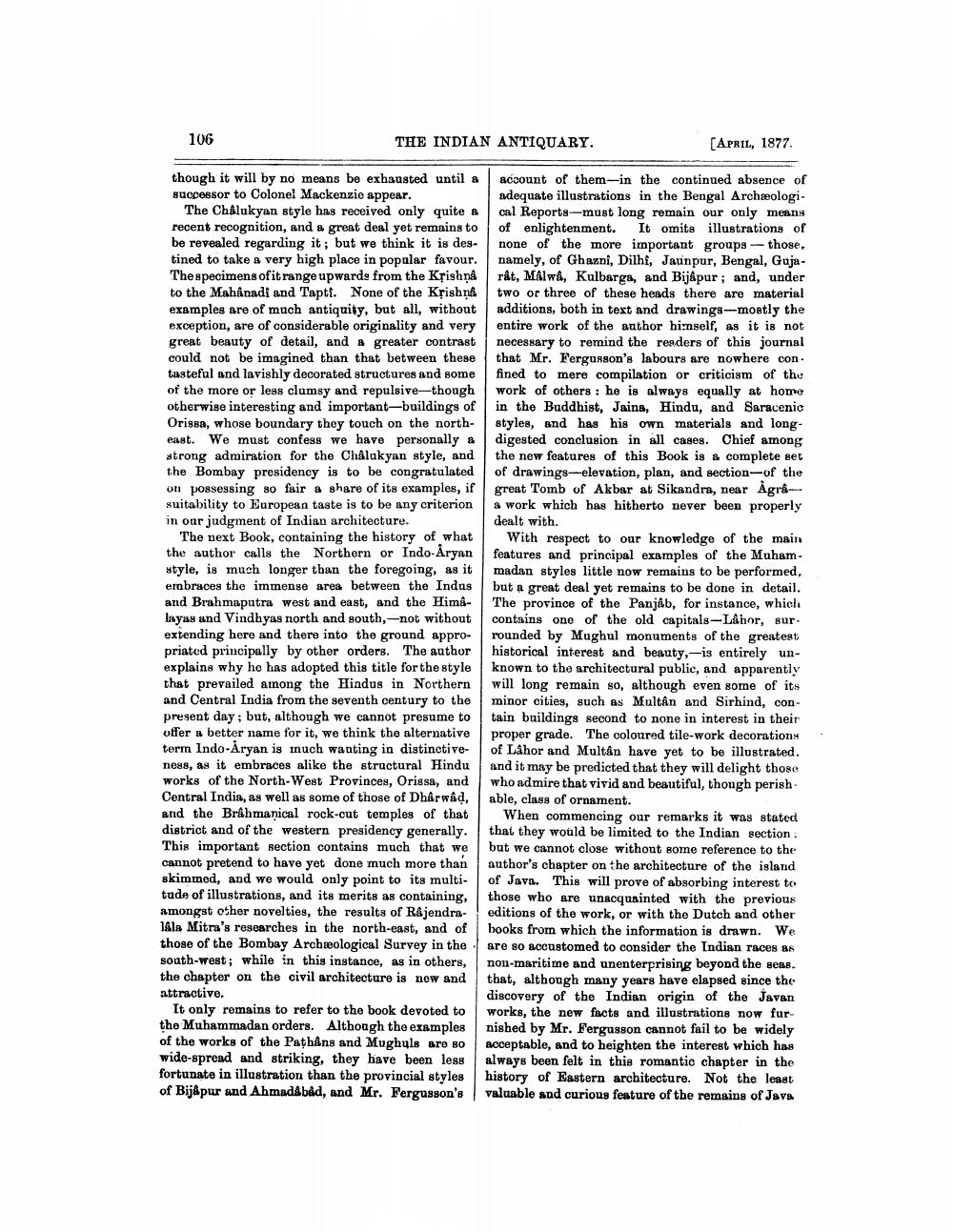________________
106
THE INDIAN ANTIQUARY.
[APRIL, 1877
though it will by no means be exhausted until & Buopessor to Colonel Mackenzie appear.
The Chalukyan style has received only quite a recent recognition, and a great deal yet remains to be revealed regarding it; but we think it is des. tined to take a very high place in popular favour. The specimens of it range upwards from the Krishna to the Mahanadi and Taptt. None of the Kộishna examples are of much antiquity, but all, without exception, are of considerable originality and very great beauty of detail, and a greater contrast could not be imagined than that between these tasteful and lavishly decorated structures and some of the more or less clumsy and repulsive-though otherwise interesting and important-buildings of Orissa, whose boundary they touch on the northeast. We must confess we have personally a strong admiration for the Chalukyan style, and the Bombay presidency is to be congratulated on possessing 80 fair a share of its examples, if suitability to European taste is to be any criterion in our judgment of Indian architecture.
The next Book, containing the history of what the author calls the Northern or Indo-Aryan style, is much longer than the foregoing, as it embraces the immense area between the Indus and Brahmaputra west and east, and the Himalayas and Vindhyas north and south, -not without extending here and there into the ground appropriated principally by other orders. The author explains why he has adopted this title for the style that prevailed among the Hindus in Northern and Central India from the seventh century to the present day:but, although we cannot presume to offer a better name for it, we think the alternative term Indo-Aryan is inuch wanting in distinctive- ness, as it embraces alike the structural Hindu works of the North-West Provinces, Orissa, and Central India, as well as some of those of Dharwad, and the Brahmanical rock-cut temples of that district and of the western presidency generally. This important section contains much that we cannot pretend to have yet done much more than skimmed, and we would only point to its multitude of illustrations, and its merits as containing, amongst other novelties, the results of R&jendra
Ala Mitra's researches in the north-east, and of those of the Bombay Archæological Survey in the south-west; while in this instance, as in others, the chapter on the civil architecture is new and attractive.
It only remains to refer to the book devoted to the Muhammadan orders. Although the examples of the works of the Pathans and Mughuls are so wide-spread and striking, they have been less fortunate in illustration than the provincial styles of Bijapur and AhmadAbad, and Mr. Fergusson's
account of them-in the continued absence of adequate illustrations in the Bengal Archaeologi. cal Reports-must long remain our only means of enlightenment. It omits illustrations of none of the more important groups those. namely, of Ghazni, Dilhi, Jaunpur, Bengal, Gujarât, Malwa, Kulbarga, and Bijapur ; and, under two or three of these heads there are material additions, both in text and drawings-mostly the entire work of the author himself, as it is not necessary to remind the readers of this journal that Mr. Fergusson's labours are nowhere con. fined to mere compilation or criticism of the work of others : he is always equally at home in the Buddhist, Jaina, Hindu, and Saracenic styles, and has his own materials and longdigested conclusion in all cases. Chief among the new features of this book is a complete set of drawings-elevation, plan, and section-of the great Tomb of Akbar at Sikandra, near Agria work which has hitherto never been properly dealt with
With respect to our knowledge of the main features and principal examples of the Muham. madan styles little now remains to be performed, but a great deal yet remains to be done in detail, The province of the Panjab, for instance, which contains one of the old capitals-Lahor, eur. rounded by Mughul monuments of the greatest historical interest and beauty,-is entirely unknown to the architectural public, and apparently will long remain so, although even some of its minor cities, such as Multân and Sirhind, contain buildings second to none in interest in their proper grade. The coloured tile-work decorations of Lahor and Multan have yet to be illustrated. and it may be predicted that they will delight those who admire that vivid and beautiful, though perish able, class of ornament.
When commencing our remarks it was stated that they would be limited to the Indian section but we cannot close without some reference to the author's chapter on the architecture of the island of Java. This will prove of absorbing interest to those who are unacquainted with the previous editions of the work, or with the Dutch and other books from which the information is drawn. We are so accustomed to consider the Indian races as non-maritime and unenterprising beyond the sens. that, although many years have elapsed since the discovery of the Indian origin of the Javan works, the new facts and illustrations now fur nished by Mr. Fergusson cannot fail to be widely acceptable, and to heighten the interest which has always been felt in this romantic chapter in the history of Eastern architecture. Not the least valuable and curious feature of the remains of Java




